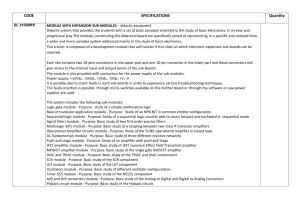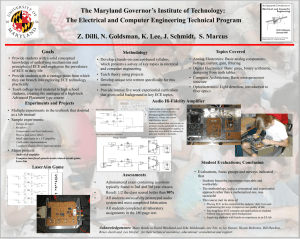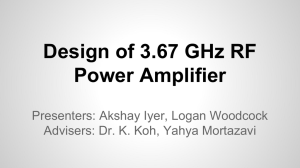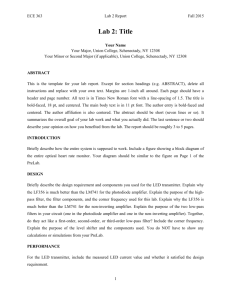CHAPTER 2 POWER AMPLIFIER 2.0 Introduction
advertisement
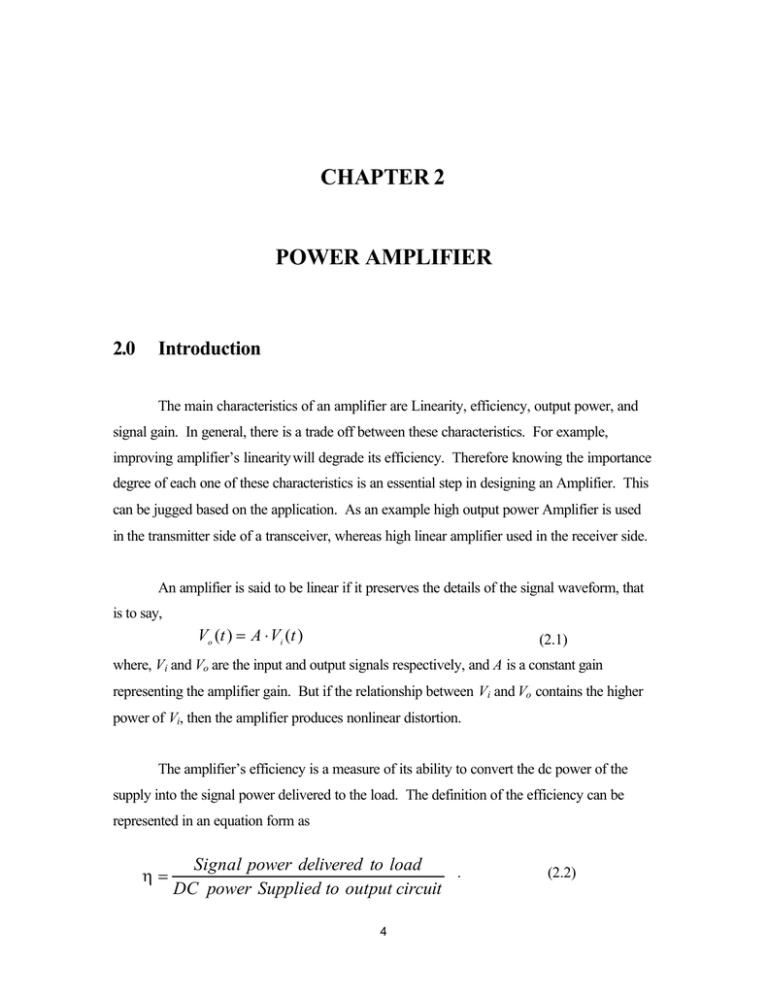
CHAPTER 2 POWER AMPLIFIER 2.0 Introduction The main characteristics of an amplifier are Linearity, efficiency, output power, and signal gain. In general, there is a trade off between these characteristics. For example, improving amplifier’s linearity will degrade its efficiency. Therefore knowing the importance degree of each one of these characteristics is an essential step in designing an Amplifier. This can be jugged based on the application. As an example high output power Amplifier is used in the transmitter side of a transceiver, whereas high linear amplifier used in the receiver side. An amplifier is said to be linear if it preserves the details of the signal waveform, that is to say, Vo ( t ) = A ⋅ Vi ( t ) (2.1) where, Vi and Vo are the input and output signals respectively, and A is a constant gain representing the amplifier gain. But if the relationship between Vi and Vo contains the higher power of Vi, then the amplifier produces nonlinear distortion. The amplifier’s efficiency is a measure of its ability to convert the dc power of the supply into the signal power delivered to the load. The definition of the efficiency can be represented in an equation form as η= Signal power delivered to load . DC power Supplied to output circuit 4 (2.2) 5 For an ideal amplifier, the efficiency is one. Thus, the power delivered to the load is equal to the power taken from the DC supply. In this case, no power would be consumed in the amplifier. In reality, this is not possible, especially in high frequency realm of RF circuits. In many high frequency systems, the output stage and driver stage of an amplifier consumed power in the amplification process. The gain of the amplifier (G) is equal to the magnitude of the output signal (Xo ) over the magnitude of the input signal (Xi) as shown in the equation. G = Xo Xi . (2.3) G can be voltage, current, or power gain depending on the application. The output power level plays an important role in evaluating the power amplifier. The power output capability factor, PMAX, is the power output that would be produced with stresses of 1 Volt and 1 Amp on the drain of the field effect transistor (FET). Multiplication of PMAX by the drain voltage and current ratings of a real device produces the maximum output power available from that device. The power output capability factor is PMAX = The Maximum Output Power . The Peak Drain Voltage × The Peak Drain Current (2.4) 2.1 Amplifier Classification Amplifiers are classified according to their circuit configurations and methods of operation into different classes such as A, B, C, and F. These classes range from entirely linear with low efficiency to entirely non-linear with high efficiency. The analysis presented in this chapter assumes piecewise-linear operation of the active device. The majority of this 6 information is available in Solid State Radio Engineering by Krauss, Bostain, and Raab [1980]. The active device used in this research is the field effect transistor. The reason for choosing this type of transistor is its superior performance in the microwave range The characteristics of the FET can be described by: iD = 0 cut-off region, iD = g m ⋅ (VGS − VT ) active region, (2.5) iD = VD Ron saturation region. The regions of operation are defined by: cut-off region: VGS < VT , active region : VGS ≥ VT and iD < VD/Ron , saturation region: VGS ≥ VT and iD = VD/Ron . The term “saturation” is used here to denote the region where further increase in gate voltage produces no increase in drain current, that is to say, iD is independent of VGS. 2.2.1 Class A The class-A amplifier has the highest linearity over the other classes. It operates in a linear portion of its characteristic; it is equivalent to a current source. As shown in figures.2.1 and 2.2, the configurations of class-A, B, and C amplifiers can be either a push–pull or a single ended tuned version. Figure.2.3 shows the load-line and current waveform for the class-A amplifier. To achieve high linearity and gain, the amplifier’s base and drain dc voltage should by chosen properly so that the amplifier operates in the linear region. The device, since it is on 7 (conducting) at all times, is constantly carrying current, which represents a continuous loss of power in the device. As shown in Fig.2.3, the maximum ac output voltage Vom is slightly less than VDD and the maximum ac output current Iom is equal to Idq. In the inductor-less system, the output voltage Vom will not be able to rise above the supply voltage, therefore, the swing will be constrained to VDD/2 and not VDD. The drain voltage must have a dc component equal to that of the supply voltage and a fundamental-frequency component equal to that of the output voltage; hence VD (θ ) = V DD + Vom ⋅ sin θ . (2.6) The dc power is Pdc = VDD ⋅ I dq , (2.7) the maximum output power is Po = 1 1 ⋅ V om ⋅ I om ≈ ⋅ V DD ⋅ I dq , 2 2 (2.8) and the efficiency is η= Po 1 V ⋅ 100 = ⋅ om ⋅ 100 ≤ 50% . Pdc 2 VDD (2.9) The difference between the dc power and output power is called power dissipation: Pd = Pdc − Po . (2.10) 8 Figure 2.1. Single-ended Power Amplifier (Class A, B, or C) 9 (a) (b) Figure 2.2. a. Complementary Push–pull Power Amplifier (Class A, B, or C) b.Transformer-coupled Push–pull Power Amplifier (Class A, B, or C) 10 Id (mA) 300 250 VGS5 200 VGS4 VGS3 150 (Vdd,Idq) Idq 100 VGS2 VGS1 50 0 0 5 10 Vdd 15 20 Vds (V) 450 400 Id (mA) 350 300 250 200 Idd 150 100 50 0 0 0.2 0.4 0.6 0.8 1 Time (nsec) Figure 2.3. Load line and current waveform for the class-A power amplifier 11 2.2.2 Class B The class-B amplifier operates ideally at zero quiescent current, so that the dc power is small. Therefore, its efficiency is higher than that of the class-A amplifier. The price paid for the enhancement in the efficiency is in the linearity of the device. Figure 2.4 shows how the class-B amplifier operates. The output power for the singleended class-B amplifier is 1 Po = ⋅ I om ⋅ Vo . 2 (2.11) the dc drain current is I dc = 2 I om , π (2.12) the dc power is Pdc = 2 I om ⋅ VDD , π (2.13) and the maximum efficiency when Vom = VDD is η= Po π V ⋅ 100 = ⋅ om ⋅ 100 ≤ 78.53% . Pdc 4 V DD (2.14) 12 Id (mA) 300 250 VGS5 200 VGS4 VGS3 150 VGS2 100 VGS1 50 Idq 0 0 5 Vdd 10 Vds (V) 15 20 250 Iom Id (mA) 200 150 100 50 0 0 0.2 0.4 0.6 Time (nsec) 0.8 1 Figure.2.4. Load line and current waveform for the class-B power amplifier 13 2.2.3 Class AB The class-AB amplifier is a compromise between class A and class B in terms of efficiency and linearity. The transistor is biased as close to pinch-off as possible, typically at 10 to 15 percent of Idss. In this case, the transistor will be on for more than half a cycle, but less than a full cycle of the input signal. 2.2.4 Class C The previous classes, A, B, and AB are considered linear amplifier, where the output signal’s amplitude and phase are linearly related to the input signal’s amplitude and phase. In the application where linearity is not an issue, and efficiency is critical, non-linear amplifier classes (C, D, E, or F) are used. Class-C amplifier is the one biased so that the output current is zero for more than one half of an input sinusoidal signal cycle. Figure 2.5 illustrates the operation of the class-C amplifier. A tuned circuit or filter is a necessary part of the class-C amplifier. Classes-A, AB, B, and C amplifiers can be defined in terms of the conduction angle Y as follows: A , B , Class of operation = AB C , y= π π y= 2 π , < y <π 2 π y< 2 (2.15) 14 The conduction angle is Y = arccos(− I dq I dd ) . (2.16) The dc current is I dc = = 1 2π 1 ⋅ ∫ i D (θ )dθ = ⋅ ( I dq ⋅ y − I dd ⋅ sin( y) 2π 0 π I dd ⋅ (sin( y) − y cos(y)) . π (2.17) Also, the output voltage (Vo ) can be obtained in term of Y as 1 2π R Vo = ⋅ ∫ i D (θ ) ⋅ R ⋅ dθ = ⋅ [4I dq ⋅ sin( y) + 2I dd ⋅ y + I dd ⋅ sin( 2 y )] 2π 0 2π = I dd ⋅ R ⋅ [2 y − sin( 2 y) ] 2π . (2.18) The output power is Vo2 , Po = R (2.19) the dc power is Pdc = Vcc ⋅ I dd , (2.20) and the maximum output voltage Vo is V OMAX = VDD . (2.21) From the above equations the maximum efficiency is ηmax = POMAX 2 y − sin( 2 y) . = Pi 4 ⋅ [sin( y) − y ⋅ cos(y) ] (2.22) 15 Since the peak drain voltage and drain current are VDMAX = 2V DD , (2.23) and I DMAX = I dq + I dd (2.24) respectively, the power output capability factor is ηmax = POMAX 2 y − sin( 2 y) . = VDMAX ⋅ I DMAX 8π ⋅ [1 − cos( y)] (2.25) Figure.2.6 shows the maximum efficiency versus the conduction angle. Although it is shown that 100% efficiency is possible, it is impractical because the output power is zero, as shown in Fig.2.7. Although the preceding analysis was for the single-ended amplifier configuration, a similar analysis can be done for the push-pull amplifier configuration. During the positive half of the signal swing, one device will push the current to the load, and during the negative half signal swing, the other device will pull the current from the load. For example, in a class-B push-pull power amplifier, every device is on for one half of the input cycle, which means that the conduction angle is equal to 180 degrees for each device. This is similar to two class-B single-ended power amplifiers connected in a parallel line. From this observation, it is possible to conclude that the efficiency of the push-pull power amplifier is the same as that of the single-ended power amplifier with the same conduction angle, and the output power capability of the push-pull power amplifier is twice that of the single-ended power amplifier. And this result is due to using two FETs. 16 280 Id (mA) 240 VGS5 200 VGS4 160 VGS3 120 VGS2 80 VGS1 40 0 0 5 10 Vdd 15 20 Vds (V) 150 100 50 Y Idd Id (mA) 0 -50 0 0.2 Idq 0.4 0.6 0.8 1 1.2 -100 -150 -200 -250 -300 Time (nsec) Figure 2.5. Load line and current waveform for the class-C power amplifier 17 100 Efficiency 80 60 50 40 20 0 0 0.5 1 1.5 2 2.5 3 Conduction Angle Figure 2.6. Efficiency vs. conduction angle 0.14 0.12 PMAX 0.1 0.08 0.06 0.04 0.02 0 0 0.5 1 1.5 2 Conduction Angle Figure 2.7. PMAX vs. conduction angle 2.5 3 18 2.2.4 Class F The class-F amplifier is one of the highest efficiency amplifiers. It uses harmonic resonators to achieve high efficiency, which resulted from a low dc voltage current product. In other words, the drain voltage and current are shaped to minimize their overlap region. Figure.2.8 shows a class-F amplifier. The inductor L3 and capacitor C3 are used to implement a third harmonic resonator that makes it possible to have a third harmonic component in the collector voltage. The output resonator is used to filter out the harmonic, keeping only the fundamental frequency at the output. The magnitude and the phase of the third harmonic control the flatness of the collector voltage and the power of amplifier. The drain voltage is V d (θ ) = V DD + V om ⋅ sin θ + V om3 ⋅ sin( 3θ ) . The setting Vom3 = (2.26) Vom produces maximum flatness for the drain voltage. And, the 9 maximum output occurs when the minimum point of Vd (θ) is zero. Hence, 9 Vom = ⋅ VDD . 8 (2.27) The dc current is I dc = I dm , π (2.28) the dc power is Pdc = VDD ⋅ I dm , π the fundamental current is (2.29) 19 I om = I dm ⋅ sin θ , 2 (2.30) the maximum fundamental output power is Po max = I dm ⋅ Vom , 4 (2.31) and, the maximum efficiency is η max = Po max Pdc I dm 9 V DD 4 8 ⋅ 100 = ⋅ ⋅ 100 = 88.36% . I dm VDD π (2.32) 20 Figure 2.8. Single-ended power amplifier (class-F) 21 2.2.5 Other High-Efficiency Classes There are other high-efficiency amplifiers such as D, E, G, H, and S. These classes use different techniques to reduce the average collector or drain power, which, in sequence, increase the efficiency. Classes D, E, and S use a switching technique, while classes G and H use resonators and multiple power-supply voltage to reduce the collector current-voltage product. A detailed analysis of class-E amplifier will be presented in Chapter 5. Designers select the class type to be used based on the application requirements. Classes-A, AB, and B amplifiers have been used for linear applications such as amplitude modulation (AM), single-sideband modulation (SSB), and quadrate amplitude modulation (QAM). Also it can be used in linear and wide band applications such as the multi–carrier power amplifier. Classes C, D, E, F, G, and H have satisfied the need for narrowband tuned amplifiers of higher efficiency. Such applications include amplification of FM signals. 22 2.3 Main Physical Limitations The descriptions of amplifiers in the previous sections have dealt with ideal devices. In reality, transistor amplifiers suffer from a number of limitations that influence amplifier operation and ultimately reduce their efficiency and output power. In practical FET, there are four fundamental effects that force the operation of FET to deviate from the ideal case: the drain source resistance, the maximum channel current If, the open channel avalanche breakdown voltage, and the drain-source break down voltage [Robert, 1988]. Figure 2.9 shows IDS-VDS characteristics of a typical MESFET (ATF-46100). Figure 2.9. IDS -VDS characteristics of a typical MESFET. 23 2.4 Nonlinear MESFET Model The development of a large-signal model for the transistor is an important step in the design of a nonlinear amplifier. The transistor model consists of linear and nonlinear circuit elements, where the latter are described by a set of nonlinear equations. Figure 2.10 shows a lumped-element model of the MESFET that can be used either in a small-signal or a largesignal analysis. Rg is the ohmic resistance of the gate, and Rs and Rd are the source and drain ohmic resistances, respectively. Cds, and Cg and C d are the drain-source capacitance and gatechannel capacitances respectively. Several authors have proposed number of nonlinear MESFET models such as the Curtice-Ettenberg model, the Staz model, and the Tom model. Rg G Cg(V g,Vd)) Rd Cd(V g,Vd)) + V _g D + Vd _ Id(V g,Vd)) Cds Ri Rs S Figure 2.10 GaAs MESFET nonlinear equivalent circuit. 24 2.5 Nonlinear analysis Having obtained a suitable model for the large signal behavior of the FET, the next step is to select the analysis method. There are two methods: frequency-domain techniques, and time domain techniques. Harmonic-balance analysis and Volterra-series analysis are the most important frequency-domain techniques. In the harmonic balance technique, the nonlinear circuit is partitioned into linear and nonlinear subcircuits. The linear subcircuit can be described by its Y, S, or any other parameters. The nonlinear elements are modeled by their I/V characteristics. The voltages at the interconnections between the two subcircuits are variables that, when determined, define all the voltages and currents in the network. In the Volterra-series analysis, the nonlinear elements are characterized by power series. Then the nonlinear transfer function can be obtained using the convolution. In the time-domain techniques, conventional circuit theory is used to obtain timedomain differential equations that describe a nonlinear circuit. These differential equations are solved numerically. A major disadvantage of time-domain analysis is that a steady state solution, which is the only one of interest in amplifier design, often requires several cycles and, consequently, a long computation time. More information about the nonlinear analysis methods for the amplifier circuits is available in Nonlinear Microwave Circuits by Stephen Maas [1987].

